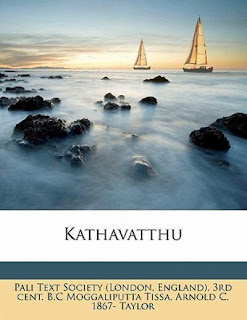Kathāvatthu (Pāli) (abbrev. Kv, Kvu), translated as "Points of Controversy", is a Buddhist scripture, one of the seven books in the Theravada Abhidhamma Pitaka. The text contrasts the orthodox Theravada position on a range of issues to the heterodox views of various interlocutors; the latter are not identified in the primary source text, but were speculatively identified with specific schools of thought in the (historically subsequent) commentaries. The original text is putatively dated to coincide with the reign of King Ashoka, but this, too, is debatable.[citation needed]
Translation: Points of Controversy, tr. S.Z. Aung & C.A.F. Rhys Davids (1915, 1993), Pali Text Society, Bristol.
Origins
The Kathavatthu was compiled in order to clarify the various points of controversy regarding Dhamma that had arisen among early Buddhist schools. Some modern readers presume that these disputes had provided the rationale for the convening of the Third Buddhist Council in the 3rd Century BCE.[citation needed] The commentaries presume that the non-orthodox views were posed by well-established schools of Buddhist philosophy (other than the Theravada) in ancient India, and this, too, may entail anachronisms, or may simply be incompatible with the earlier date of authorship that tradition has presumed.[citation needed]
According to tradition, this work was compiled by the venerable Moggaliputta Tissa in his role as leader of the Third Council.[1] The Kathavatthu is said to record the answers that were deemed orthodox by the assembled senior monks. Based on linguistic, thematic and structural evidence, it seems likely that Moggaliputta Tissa only began the work, with further debates added as more "heresies" came to the notice of Theravada authorities.
Organization
The Kathavatthu documents over 200 points of contention. The debated points are divided into four paṇṇāsaka (lit., "group of 50"). Each paṇṇāsaka is again divided, into 20 chapters (vagga) in all. In addition, three more vagga follow the four paṇṇāsaka.
Each chapter contains questions and answers by means of which the most diverse views are presented, refuted and rejected. The form of the debates gives no identification of the participants, and does not step outside the debate to state explicitly which side is right.
The views deemed non-heretical by the commentary's interpretation of the Katthavatthu were embraced by the Theravada denomination. According to the Commentaries those whose views were rejected include the Sarvastivada.
Canonicity
The inclusion of the Kathavatthu in the Abhidhamma Pitaka has sometimes been thought of as something of an anomaly. First, the book is not regarded as being the words of the Buddha himself - its authorship is traditionally attributed to Moggaliputta Tissa. However this is not unusual: the Vinaya's accounts of the first two Councils are obviously also not the Buddha's actual words. Second, the subject matter of the Kathavatthu differs substantially from that of the other texts in the Abhidhamma – but this is true of the Puggalapannatti as well.
Scholars sometimes also point to the inclusion of some obviously later (relatively new) sections of the Kathavatthu in the Tipitaka as an indication that the Pāli Canon was more 'open' than has sometimes been thought, and as illustrative of the process of codifying new texts as canonical. In fact this too is not unusual, there being quite a bit of relatively late material in the Canon.
Interpretation
The debates are understood by the tradition, followed by many scholars, as disputes between different schools of Buddhism. However, L. S. Cousins, described by Professor Gombrich as the West's leading abhidhamma scholar, says:
"In spiritual traditions the world over, instructors have frequently employed apparent contradictions as part of their teaching method – perhaps to induce greater awareness in the pupil or to bring about a deeper and wider view of the subject in hand. The Pali Canon contains many explicit examples of such methods. (Indeed much of the Kathāvatthu makes better sense in these terms than as sectarian controversy.)"

0 comments:
Post a Comment